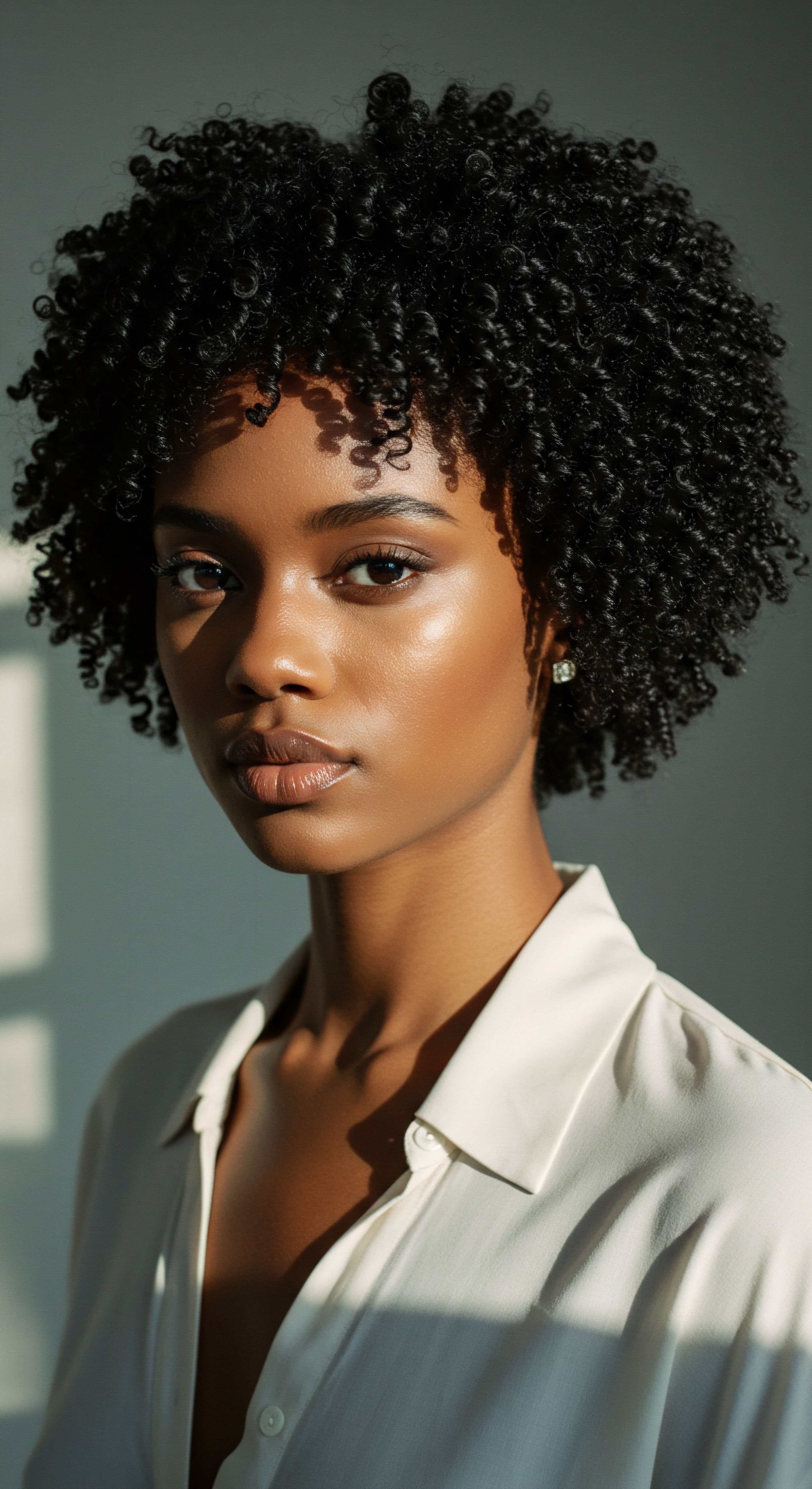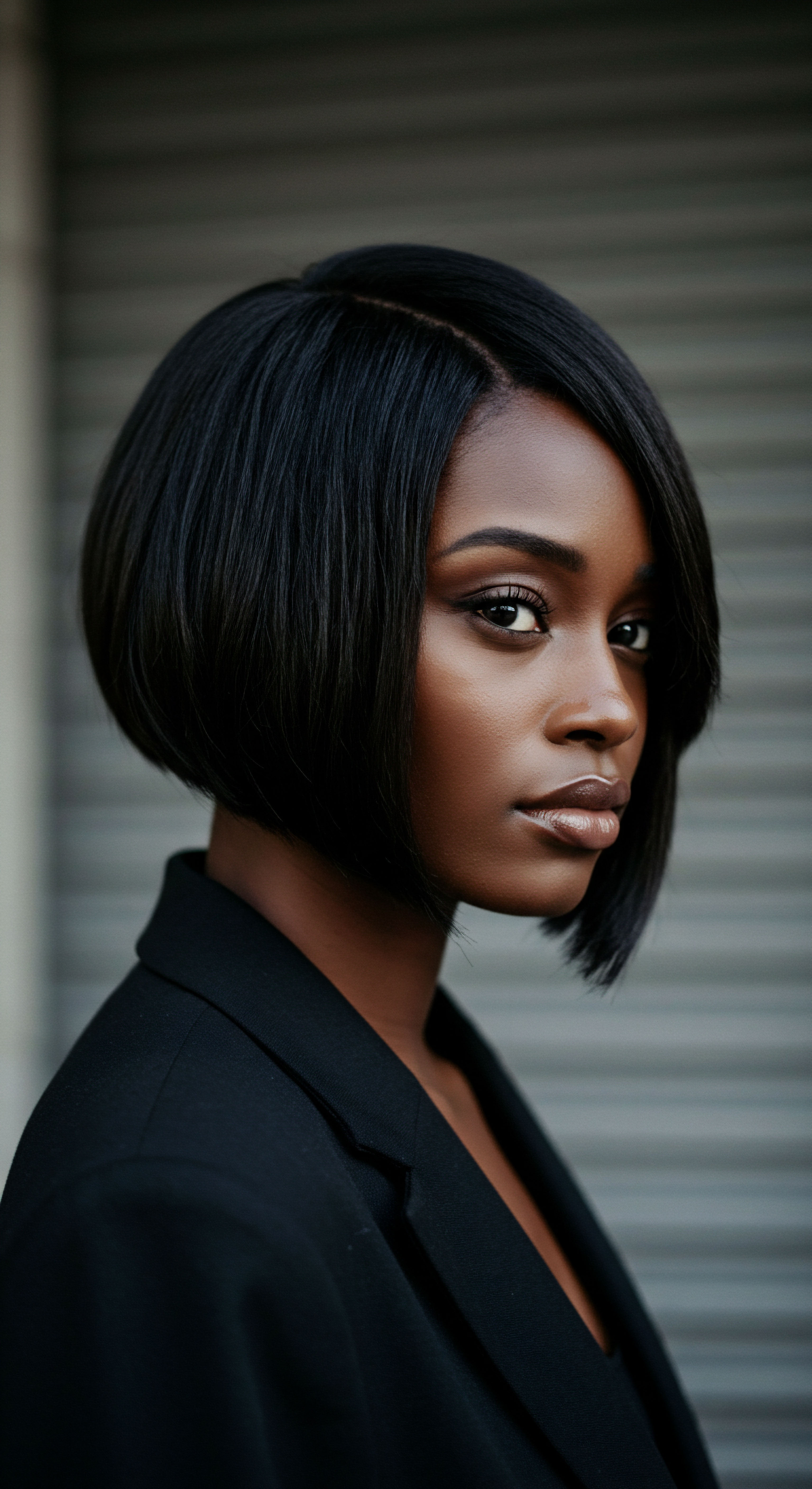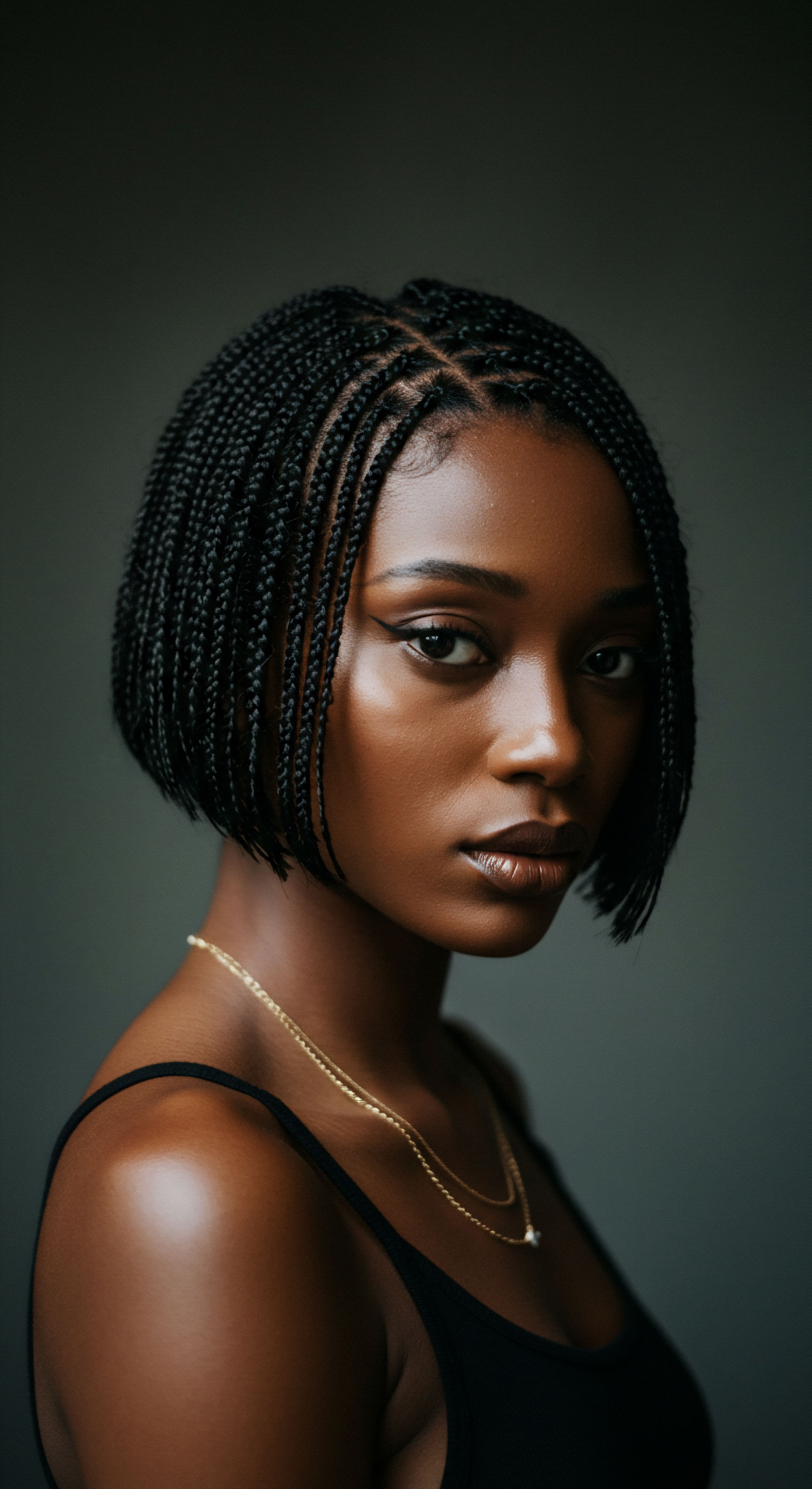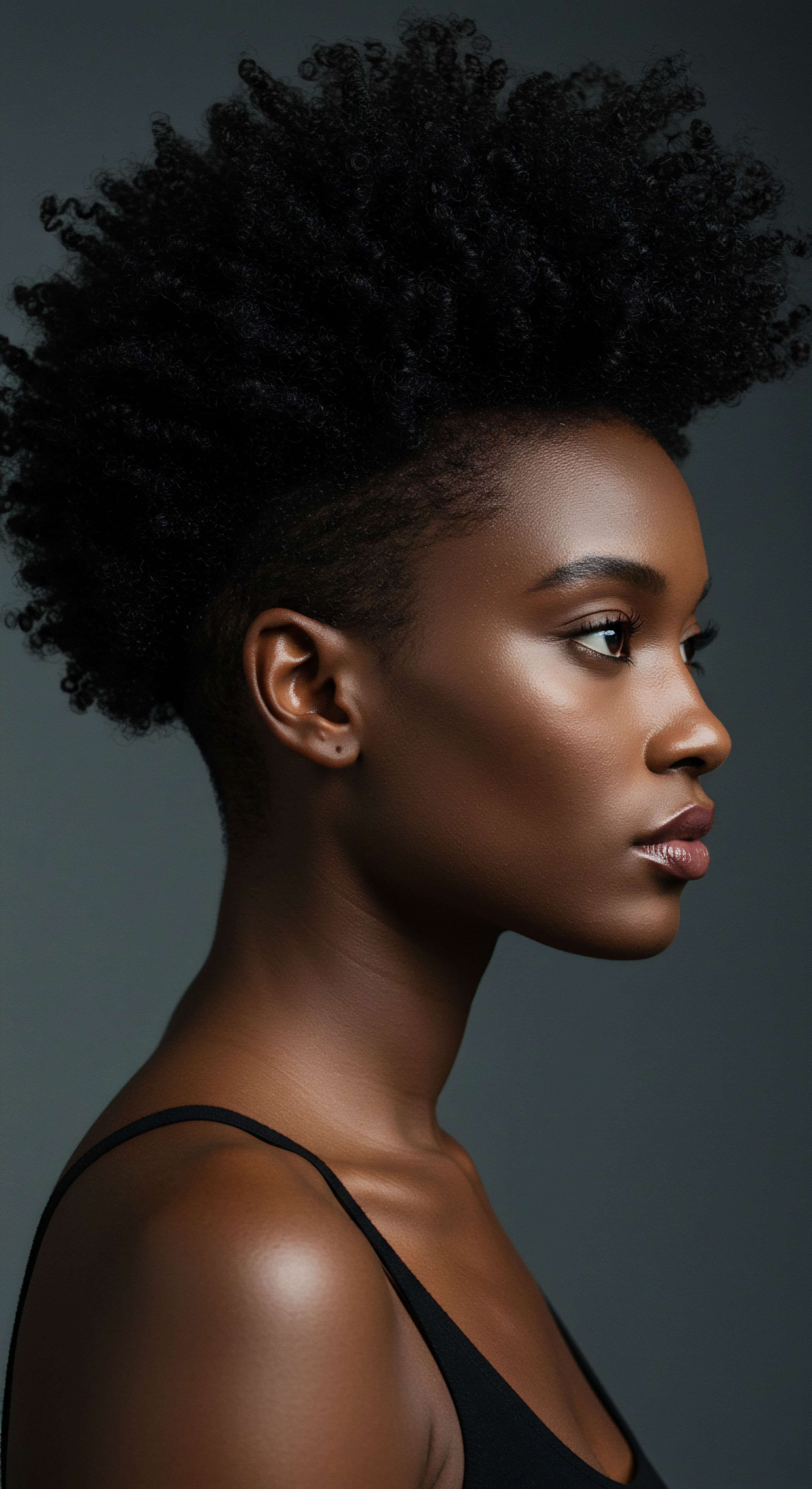
Roots
Beneath the vibrant crown of every textured strand lies a quiet, constant conversation with its environment, a dialogue often overlooked when the world quiets for the night. To truly tend to these coils, kinks, and waves, we must first bow to their fundamental truths, the silent wisdom held within each filament. This foundational understanding, akin to tracing a river to its source, reveals why the seemingly simple act of preparing for slumber holds such profound weight for hair that defies gravity and dances with its own unique rhythm. It is here, in the quiet hours, that the subtle mechanics of preservation or inadvertent damage begin their work, shaping the very resilience and vibrancy we seek.

Hair Anatomy and the Night’s Quiet Forces
The architecture of textured hair is a marvel, distinct in its helical structure, its elliptical cross-section, and the uneven distribution of disulfide bonds. These characteristics grant it its captivating spring and volume, yet simultaneously render it more susceptible to mechanical friction and moisture loss. Unlike straight hair, which allows natural oils to travel down the shaft with ease, the bends and turns of textured strands create barriers, often leaving ends thirsting for hydration. When we lay our heads down, these delicate structures face a nightly gauntlet of friction against pillows, sheets, and even other strands.
The cuticle, the outermost protective layer, can lift and abrade, exposing the inner cortex to damage. This understanding forms the bedrock of why nocturnal protection becomes a silent guardian.
Consider the delicate balance of the scalp’s ecosystem. A healthy scalp is the fertile ground from which resilient strands spring. During sleep, our bodies engage in repair and regeneration, processes that extend to the scalp. Blood flow to the scalp can fluctuate, and cellular repair mechanisms are at their peak.
Any disruption to this nocturnal rhythm, whether from an unsuitable sleep surface or improper hair preparation, can ripple through the hair follicle, potentially affecting its ability to produce healthy, strong hair. The interaction between hair and its sleep environment is not merely superficial; it touches upon the very physiological processes that sustain hair health.
The distinct architecture of textured hair, with its helical structure and elliptical cross-section, renders it more susceptible to friction and moisture loss during sleep.

Moisture’s Nocturnal Retreat
Textured hair’s innate tendency towards dryness is a well-documented aspect of its care. Its structure makes it challenging for sebum, the scalp’s natural oil, to descend the hair shaft, leaving the lengths and ends vulnerable. The ambient humidity of a bedroom, the materials of our bedding, and even our own body heat can contribute to a subtle yet steady loss of moisture from the hair throughout the night. This insensible water loss, while seemingly minor, accumulates over hours, leaving strands drier and more prone to breakage upon waking.
This nightly dehydration cycle, if left unaddressed, can lead to a cascade of issues, from diminished elasticity to increased tangling. The challenge lies in mitigating this moisture exodus, transforming the sleeping space into a sanctuary of hydration.
Moreover, the concept of Transepidermal Water Loss (TEWL) extends beyond the skin to the scalp. Research indicates that sleep deprivation can compromise the skin’s barrier function, leading to increased TEWL. While specific studies on textured hair scalp TEWL during sleep are still evolving, the general principle holds ❉ a compromised scalp barrier means greater moisture escape. For textured hair, which often struggles with inherent dryness and a predisposition to certain scalp conditions, maintaining this barrier is paramount.
A 2017 study published in the Journal of Investigative Dermatology, while not exclusively on hair, reported that sleep restriction significantly increased TEWL in human skin, indicating a weakened skin barrier. This suggests a silent assault on the scalp’s moisture reserves, making proactive measures before sleep a non-negotiable step in hair care.

Understanding Hair Growth Cycles in Darkness
Hair growth is not a linear, constant process; it cycles through distinct phases ❉ anagen (growth), catagen (transition), and telogen (resting). While sleep itself does not directly alter these cycles, the overall health and well-being supported by restorative sleep certainly influence their optimal progression. Chronic sleep deprivation, for instance, can elevate stress hormones like cortisol. Sustained high cortisol levels have been linked to a phenomenon known as Telogen Effluvium, a temporary but noticeable increase in hair shedding, where a greater proportion of hair follicles prematurely enter the resting phase.
This indirect yet potent connection underscores the systemic relationship between our body’s nightly recuperation and the vitality of our strands. The body’s restorative processes during deep sleep directly contribute to cellular repair and regeneration, including those within the hair follicles, thereby supporting a robust anagen phase and minimizing premature shedding.
Furthermore, the subtle shifts in temperature and humidity within the sleep environment can affect the cuticle’s integrity over time. A consistent, friction-rich environment can slowly erode the cuticle, making the hair more porous and less able to retain moisture. This cumulative damage, occurring silently each night, can undermine even the most diligent daytime care routines. Recognizing these nocturnal forces allows us to pivot from merely styling our hair to truly safeguarding its fundamental structure and health, transforming the act of going to sleep into an active step in hair preservation.

Ritual
Stepping from the foundational understanding of hair’s nocturnal vulnerabilities, we now turn to the conscious practices that transform the quiet hours into a period of deep replenishment. This “Ritual” section acknowledges that care for textured hair extends beyond daytime styling; it reaches into the deliberate preparation for rest, turning a mundane act into a sacred moment of protection. It is here that the gentle wisdom of proactive measures meets the daily rhythms of life, offering tangible ways to honor and preserve the unique character of coils and kinks. We consider how simple, yet profound, actions before slumber can create a sanctuary for strands, shielding them from the unseen forces of friction and dehydration that silently work against their vitality.

The Nighttime Sanctuary Essential Sleep Protection
The primary purpose of nighttime hair protection for textured hair is to minimize friction and prevent moisture loss. When textured hair rubs against abrasive surfaces like cotton pillowcases, it experiences significant mechanical stress. This friction causes the delicate cuticle scales to lift and eventually chip away, leading to frizz, tangles, and ultimately, breakage.
This is particularly pronounced for textured hair due to its inherent structural fragility and tendency to tangle. The continuous rubbing can also absorb essential moisture and natural oils from the hair, exacerbating dryness and leaving strands brittle.
The solution often lies in creating a protective barrier between the hair and the sleep surface. This barrier can take several forms, each offering distinct benefits for different preferences and hair types. The choice of protection is not merely about convenience; it is a deliberate act of care, acknowledging the hair’s unique needs during its most vulnerable hours. The goal is to allow the hair to rest undisturbed, preserving its integrity and moisture content, so it can awaken refreshed and resilient.

Choosing Your Hair’s Nocturnal Armor
- Silk or Satin Bonnets ❉ These are often considered the gold standard for nighttime protection. Silk and Satin fabrics possess a smooth, low-friction surface that allows hair to glide rather than snag. This significantly reduces mechanical damage and minimizes frizz. Furthermore, unlike cotton, these materials do not absorb moisture from the hair, helping to preserve its natural hydration and any applied products. A well-fitting bonnet stays securely in place, keeping strands contained and protected throughout the night.
- Silk or Satin Pillowcases ❉ For those who find bonnets uncomfortable or prefer less restriction, a silk or satin pillowcase offers an excellent alternative. The principle remains the same ❉ a smooth surface reduces friction. While a pillowcase might not offer the same level of containment as a bonnet, it still provides substantial protection against breakage and moisture depletion, particularly for longer or looser textured hair types.
- Pineapple Method ❉ This involves loosely gathering hair into a high ponytail on top of the head, secured with a soft scrunchie. The hair then falls freely, minimizing contact with the pillow. This method is particularly beneficial for preserving curls and waves, reducing flattening and frizz. It can be combined with a silk pillowcase for additional protection.
Creating a protective barrier between hair and sleep surface, often through silk or satin, minimizes friction and preserves essential moisture.

Preserving Style and Definition
Beyond preventing damage, sleep hygiene plays a pivotal role in preserving textured hair styles and definition. Many textured hair styles, from defined curls to intricate braids, are sensitive to disruption. A night of unprotected tossing and turning can undo hours of styling effort, leading to flattened roots, frizz, and loss of curl pattern. Strategic nighttime preparation can significantly extend the life of a style, reducing the need for frequent restyling and minimizing heat or manipulation damage.
Consider the impact on delicate curl patterns. Each coil and wave holds its shape due to hydrogen bonds within the hair structure. These bonds are susceptible to disruption by friction and moisture changes.
By encasing the hair in a smooth, stable environment, these bonds are less likely to be disturbed, allowing curls to maintain their definition and bounce. For protective styles like braids, twists, or locs, a bonnet or headwrap prevents loosening, frizzing, and premature unraveling, thereby extending the longevity of the style and protecting the underlying hair.

What Practical Steps Can We Take Before Sleep?
- Moisturize and Seal ❉ Before covering hair, applying a leave-in conditioner or a light hair oil can replenish moisture lost during the day and create a protective barrier. This is especially important for textured hair, which tends to be drier. A light application of a moisturizing cream followed by a sealing oil can lock in hydration.
- Gentle Detangling ❉ Lightly detangling hair with fingers or a wide-tooth comb before bed can prevent tangles from worsening overnight. This reduces the stress on hair when detangling in the morning. However, avoid aggressive detangling, as wet hair is more fragile.
- Loose Protective Styles ❉ For those who prefer not to use bonnets or pillowcases, putting hair into a loose braid, twists, or a loose bun on top of the head can minimize friction. The key is “loose” to avoid tension on the scalp and hair follicles.
| Protection Method Silk/Satin Bonnet |
| Friction Reduction Very High |
| Moisture Retention Very High |
| Style Preservation Excellent |
| Protection Method Silk/Satin Pillowcase |
| Friction Reduction High |
| Moisture Retention High |
| Style Preservation Good |
| Protection Method Pineapple Method |
| Friction Reduction Moderate |
| Moisture Retention Moderate |
| Style Preservation Good (for curls) |
| Protection Method Loose Braids/Twists |
| Friction Reduction Moderate |
| Moisture Retention Moderate |
| Style Preservation Good (for length) |
| Protection Method Each method offers distinct advantages in safeguarding textured hair during sleep. |

Considering the Scalp’s Nocturnal Needs
While the focus often lies on the hair strands, the scalp’s health during sleep is equally significant. A healthy scalp is the foundation for healthy hair growth. Proper sleep hygiene extends to ensuring the scalp environment is conducive to its well-being.
This includes avoiding heavy, pore-clogging products before bed, which can lead to buildup and irritation. Allowing the scalp to breathe and engage in its natural regenerative processes is key.
Some individuals with textured hair experience dry scalp or specific scalp conditions. For them, nighttime can be an opportunity for targeted treatments. Applying a lightweight scalp serum or a soothing oil before bed can help alleviate dryness and calm irritation.
The protective barrier of a bonnet or pillowcase can also help these treatments absorb more effectively by preventing them from rubbing off onto bedding. The symbiotic relationship between a nourished scalp and thriving strands underscores the holistic nature of sleep hygiene for textured hair.

Relay
Having journeyed through the foundational truths and the practical rituals of nighttime care, we now step into a more expansive consideration of sleep hygiene for textured hair. This “Relay” section signals a transition into a deeper, more interconnected exploration, moving beyond surface-level discussions to consider the intricate interplay of biological, cultural, and environmental factors. It invites us to consider how the quiet hours of rest do not merely preserve strands, but actively participate in the ongoing vitality of hair, linking seemingly disparate elements into a cohesive understanding. Here, we delve into the less obvious, yet profoundly impactful, connections that solidify sleep hygiene as a cornerstone of textured hair wellness.

Beyond the Mechanical What About Cellular Repair?
The act of sleep is far more than a passive state of rest; it is a period of intense cellular repair and regeneration for the entire body, including the skin and scalp. During deep sleep cycles, the body’s production of growth hormones increases, facilitating tissue repair and cellular turnover. For the scalp, this means a prime opportunity for follicles to repair from daily environmental stressors and prepare for robust growth. Disrupted sleep patterns can interfere with these critical biological processes, potentially compromising the overall health of the hair follicle and the quality of the hair it produces.
Consider the role of the scalp microbiome, a complex community of microorganisms that plays a significant part in scalp health. Just as the gut microbiome influences overall well-being, the balance of the scalp microbiome can impact issues like dandruff, irritation, and even hair growth. While direct research on sleep’s impact on the scalp microbiome is still developing, we know that chronic stress and systemic inflammation, both exacerbated by poor sleep, can disrupt microbial balance in other parts of the body. A harmonious sleep environment, therefore, indirectly supports a balanced scalp microbiome, which in turn fosters a healthier environment for textured hair to thrive.

How Does Sleep Quality Influence Hair Growth and Health?
The relationship between sleep quality and hair health extends to systemic biological processes. Chronic sleep deprivation is a known physiological stressor. When the body is under stress, it prioritizes essential functions, sometimes diverting resources away from “non-essential” processes like optimal hair growth. The increased production of stress hormones, particularly cortisol, can influence the hair growth cycle.
Prolonged elevated cortisol can push more hair follicles into the resting (telogen) phase prematurely, leading to increased shedding. This phenomenon, known as Telogen Effluvium, is a direct manifestation of the body’s response to systemic stress, and inadequate sleep is a significant contributor.
Moreover, the body’s ability to combat oxidative stress is compromised by poor sleep. Oxidative stress, an imbalance between free radicals and antioxidants, can damage cells, including those in hair follicles. Melatonin, often associated with sleep regulation, also acts as a potent antioxidant. When sleep is disrupted, melatonin production can be affected, potentially leaving hair follicles more vulnerable to oxidative damage.
This scientific connection underscores that sleep is not merely about physical rest, but about a complex biochemical orchestration that directly impacts hair vitality. A study published in the International Journal of Trichology discussed the multifaceted causes of telogen effluvium, listing chronic sleep deprivation as a contributing factor due to its systemic stress implications.
| Factor Stress Hormones (Cortisol) |
| Impact of Poor Sleep Elevated levels |
| Hair Health Consequence Increased hair shedding (telogen effluvium) |
| Factor Cellular Repair |
| Impact of Poor Sleep Compromised regeneration |
| Hair Health Consequence Slower hair growth, weaker strands |
| Factor Oxidative Stress |
| Impact of Poor Sleep Reduced antioxidant defenses |
| Hair Health Consequence Follicle damage, premature aging of hair |
| Factor Scalp Blood Circulation |
| Impact of Poor Sleep Potentially reduced |
| Hair Health Consequence Impaired nutrient delivery to follicles |
| Factor The systemic effects of sleep quality extend deeply into the physiological processes that support vibrant hair. |

Cultural Significance and the Quiet Practice of Care
For many with textured hair, particularly within Black and mixed-race communities, hair care extends beyond mere aesthetics; it is deeply intertwined with identity, heritage, and self-expression. Nighttime hair rituals, passed down through generations, often hold a cultural significance that transcends their practical benefits. The bonnet, the scarf, the careful braiding before bed are not just protective measures; they are acts of preservation, self-respect, and continuity. These practices connect individuals to a legacy of care and resilience, reflecting a profound understanding of hair’s unique needs long before scientific terms like “transepidermal water loss” became commonplace.
The communal aspect of hair care, often seen in shared knowledge and inherited practices, underscores the cultural weight of these nighttime routines. Stories are shared, techniques are taught, and the wisdom of elders guides the younger generation in protecting their crowns. This collective understanding reinforces the importance of sleep hygiene, not as an isolated task, but as an integral component of a holistic approach to textured hair wellness. It speaks to a quiet, enduring wisdom that recognizes the hair’s vulnerability and its capacity for strength when nurtured with consistent, thoughtful attention.
The practice of “wrapping” or “covering” hair at night has historical roots in various African cultures, serving purposes of cleanliness, protection, and cultural identity. This tradition continues to be a cornerstone of modern textured hair care, embodying a continuum of care that bridges past and present. It highlights that the concept of sleep hygiene for hair is not a novel invention but a contemporary articulation of ancient wisdom, adapted for modern contexts yet retaining its core purpose of safeguarding and honoring textured strands.

Environmental Factors and the Nocturnal Microclimate
The immediate sleep environment creates a microclimate that can either support or hinder textured hair health. Beyond the friction of bedding materials, factors such as room temperature, humidity levels, and even air quality play a subtle yet cumulative role. An overly dry environment, perhaps due to heating or air conditioning, can exacerbate moisture loss from hair and scalp. Conversely, excessively high humidity might lead to frizz for some hair types, though generally, textured hair thrives in more humid conditions.
Maintaining a balanced room environment, alongside using protective coverings, creates an optimal nocturnal sanctuary. A humidifier, for instance, can replenish moisture in dry air, benefiting both hair and skin. Similarly, ensuring the sleep space is free from excessive dust or allergens can contribute to a healthier scalp environment. These environmental considerations, often overlooked, contribute to the overall effectiveness of sleep hygiene, demonstrating that caring for textured hair is a multi-dimensional endeavor that extends to the very air we breathe as we rest.

Reflection
As the final whispers of the night give way to the soft glow of dawn, the story of sleep hygiene for textured hair unfolds not as a rigid set of rules, but as a tender acknowledgment of hair’s quiet resilience. It is a testament to the profound connection between our deepest rest and the vibrant life of our strands, a reminder that true care often resides in the gentle, consistent acts performed when the world slows down. This journey through the roots of understanding, the rituals of protection, and the relay of deeper connections reveals that safeguarding textured hair during sleep is a holistic practice, weaving together scientific insight, cultural wisdom, and personal dedication. It is in these quiet moments of care that we truly honor the crown we wear, allowing it to awaken each day, refreshed, renewed, and ready to meet the light.

References
- Kanda, N. & Ishii, S. (2017). Sleep restriction affects epidermal barrier function and recovery. Journal of Investigative Dermatology, 137(10), 2095-2101.
- Headington, J. T. (1993). Telogen effluvium ❉ New concepts and new therapies. International Journal of Dermatology, 32(7), 469-479.
- Bouzari, N. & Mohammadi, F. (2014). The effect of sleep deprivation on hair loss. Iranian Journal of Dermatology, 17(1), 19-21.
- Reinking, J. (2009). Hair Care for African American Women. Dermatology Nursing, 21(1), 21-25.
- Goren, A. & Naccarato, P. (2018). Hair growth and sleep quality. Journal of Cosmetic Dermatology, 17(5), 760-761.
- American Academy of Dermatology Association. (n.d.). Hair loss ❉ Common causes of hair loss. (While not a book, this organization provides authoritative information, often referencing peer-reviewed studies).
- Gavazzoni Dias, M. F. R. (2015). Hair cosmetics ❉ An overview. International Journal of Trichology, 7(1), 2-15.
- Tobin, D. J. (2018). Hair in toxicology ❉ An important biomarker. Elsevier.